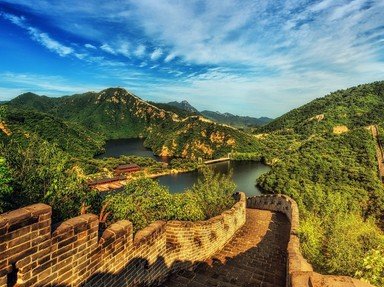Quiz Answer Key and Fun Facts
1. When the Qing were still strong, much of China was closed to foreigners before the Western nations began forcing the Chinese to open the nation to trade. Yet, Emperor Kangxi had allowed trade to take place with the Western nations at the port of Guangzhou (formerly known as Canton). Foreigners even had the liberty to live in a particular section of the city. What this area called?
2. Perhaps the turning point in China's development in history, the White Lotus Rebellion of 1796-1804 (named after the White Lotus Society that led the rebellion) could be seen as the point where the Qing Dynasty weakened irrevocably. The rebellion led to 16,000,000 deaths - probably more than the total number of dead in World War I. What was the White Lotus Society whose actions led to massive, bloody civil war?
3. In the early 19th century, China had a favorable balance of trade with the European nations with its exports worth much more than its imports. This all changed with the introduction of a single product, opium. Addiction to opium caught on like wildfire in China and the Qing government quickly responded by a campaign against the trade and use of the drug. Who headed the Chinese campaign against opium?
4. The Taiping Rebellion (1850-1864) is one of the bloodiest wars in history, with an estimated 20,000,000 people killed, another Chinese war with a greater death toll than World War I. This rebellion established the short lived kingdom called the Taiping Heavenly Kingdom, a semi-Christian theocracy, led by a man who claimed to be the brother of Jesus. While this Christian sect hadn't received recognition from Europe's Christian leaders, the followers forcefully tried replacing much of China's culture and considered themselves Christians who were serving a holy purpose. Who was this self proclaimed "holy man" that led this rebellion?
5. Despite the fact that the Taiping Rebellion was still taking place, the Second Opium War (1856-1860) began during the middle of the rebellion. With the devastating casualties and destruction caused by the Taiping Rebellion, China was in no place to fight the Western nations. The Chinese army was already weakened, and busy trying to defeat the forces of the Taiping Heavenly Kingdom who had already seized rich parts of China. Who went to war with China during the Second Opium War?
6. With China's nation pride diminished after losing several wars and making large concessions to the Western nations, several Chinese officials believed it was time for reforms. Like the Meiji Restoration that took place in the neighboring nation of Japan, this set of reforms was supposed to strengthen China militarily as well as to industrialize. However, corruption and conservatism (in this context meaning sticking to Chinese traditions and avoiding Western ideas and methods) in the government hindered the effectiveness of these reforms. What is the name of this series of reforms?
7. France and China went to war once again in 1884 over control of Vietnam. One of the most devastating battles that took place during the war severely damaged the Chinese Navy with the near elimination of the Fujian Fleet, one of China's few western-style naval fleets. It also led to the destruction of a large naval shipyard. What is the modern name of the city where this battle took place?
8. As Japan industrialized and westernized following the Meiji Restoration, the nation had decided to wage an offensive campaign against China. With Japan's newly westernized army and navy they were able to force China into an unequal treaty. Which of these was one of Japan's goals during the war?
9. In 1899 a secret society called the Boxers, also known as the Righteous Harmony Society Movement had "seized" the Chinese capital of Beijing. However, this "rebellion" had actually been supported by Empress Dowager Cixi in the hope of ridding China of Westerners. The Boxers laid siege to the various embassies in Beijing (then called Peking) and attacked Christian churches. Yet, the combined armies of the Eight-Nation Alliance (Britain, France, Germany, Japan, the United States, Russia, Italy, and Austria-Hungary) crushed the rebellion and forced a humiliating treaty on China. What is the name of this treaty?
10. This final event ended millennia of Chinese traditional dynastic monarchies and the end of nearly three centuries of Qing rule. The predecessor to what would form into the Kuomintang, the secret society and wide alliance of varying political factions called the Tongmenghui raised a revolution and overthrew the Qing government. What is this revolution known as?
Source: Author
Avalice
This quiz was reviewed by FunTrivia editor
bloomsby before going online.
Any errors found in FunTrivia content are routinely corrected through our feedback system.

